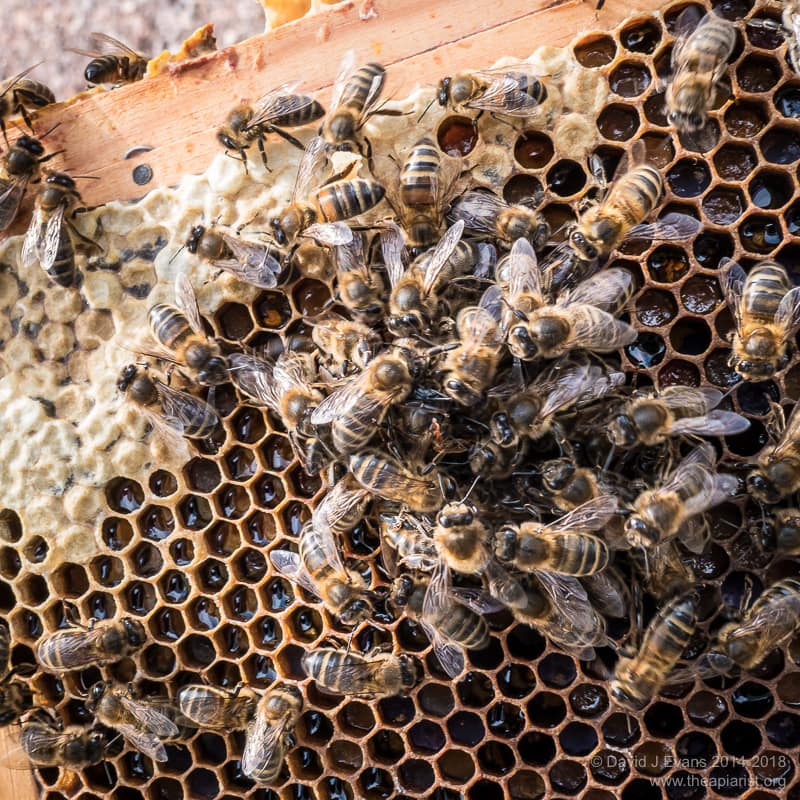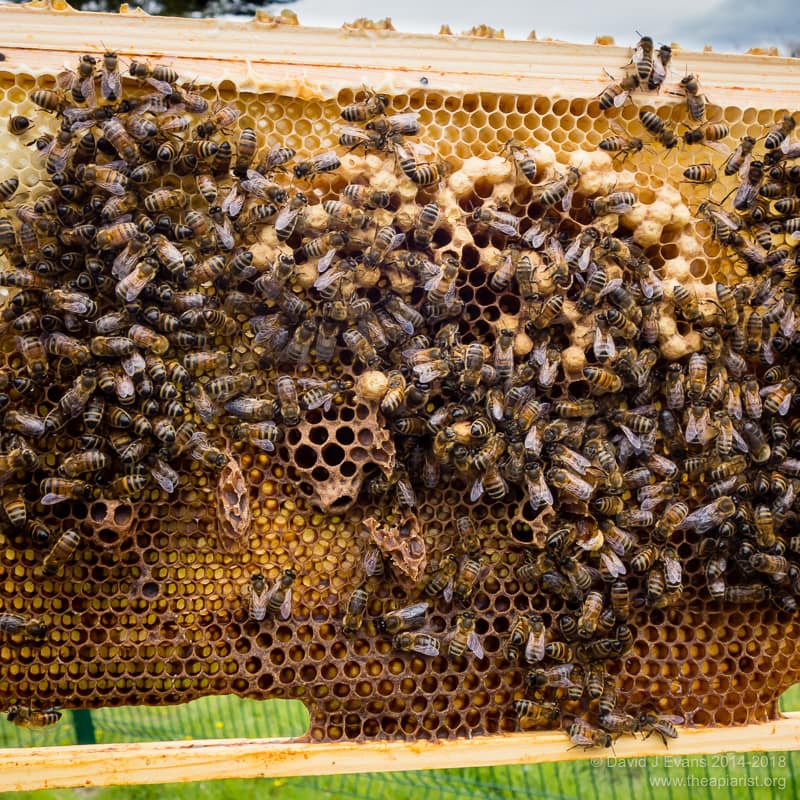Spot the queens
A little over a month ago I opened a recently-united hive to be faced with this …
That’s a ‘bit of a stooshie’ as they might say in Glasgow {{1}}. Somewhere in the middle of that brawling mass of workers is a queen.
She’s unmarked and not clipped.
This was a surprise as the queen I had expected to find in the box should have been marked blue {{2}}.
A potted history
The colony had overwintered with a 2016 white marked and clipped queen. I’d conducted a vertical split on the colony in mid-May and by early July I had two queens in the box, one above and one below the split board.
Neither of them was marked white.
A few days after setting up the split the queenright half looked very much like it was preparing to either supercede the queen or swarm. The white marked queen was still there but there were also charged queen cells present.
Either supercedure or swarming should have eventually resulted in the queen being replaced. However, the quality of her successor could not be relied upon … she might have been great, but she might have been poor. The white clipped queen was pretty good and I didn’t want to lose her {{3}}.
I therefore made up a nuc with the ‘old’ white marked queen for safety and left the box with one charged queen cell.
The upper and lower boxes of the split both eventually – by early July – contained new queens, both of which I’d marked blue and clipped.
On the 7th of July I made up a nuc for overwintering with one of the blue clipped queens. The remainder of the – now queenless – colony I united with the queenright colony below it from the original vertical split. This formed one good strong colony.
We had an excellent nectar flow in July and I got two full supers from the colony by the end of the month.
Pining for the fjords
Nine days after making up the nuc and uniting the colonies I conducted a follow-up inspection. The newspaper was chewed away and most of the bees were behaving as normal. So far, so good.
However, on one frame the bees were agitated and formed a gobstopper-sized clump. I gently teased apart the melee with my forefinger to see if there was a queen buried in the middle … there was.
Unmarked and unclipped. Puzzling.
A little further across the same frame was another queen. To paraphrase Monty Python, this queen was not ‘stunned’ or ‘pining for the fjords’, rather she was very much an ex-queen. And probably relatively recently.
So, as expected, I’d found the 2018 blue-marked and clipped queen in the united colony.
Unexpectedly, she was a corpse ?
If in doubt … wait
What was going on in the colony? Frankly, I didn’t have a Scooby’s {{4}}.
Was the (apparently) new, unmarked queen mated or a virgin? Presumably the latter. However, other colonies in the apiary were requeening and it’s not unknown for a queen to go to the wrong hive when returning from a mating flight.
Would she survive the aggravation she was receiving from the workers in the colony?
Where had the new queen come from? If not from outside she must have come from a queen cell in the split hive. However, both sides of the split had new 2018 mated queens, and the timing wasn’t really right.
Under these circumstances the best thing is often to do nothing. I closed the hive up. My notes simply state “Dead BMCLQ! Virgin?? Left them to it.” {{5}}.
No happy ending
Much as I’d like to be able to report that now, a month later, the colony is headed by a new mated queen laying frame after frame of worker brood … I can’t.
At the last inspection {{6}} the colony only contained several hand-sized patches of brood. However, it was all drone brood in worker cells.
The combination of drone brood in worker cells, with their characteristically domed cappings on sealed brood, coupled with the clustered arrangement of the brood clearly indicated that the colony contained a drone-laying queen (DLQ).
Within the patches of drone brood were one or two attempts to make queen cells. These were abnormally shaped – either short, fat and unsculpted or overly long – and are often seen in colonies with DLQs or laying workers.
It’s too late in the year (here in Fife) to get a new queen mated – at least with any certainty. The bees in the colony were old and their numbers were much reduced. I therefore cut my losses and shook the colony out in front of a row of strong hives.
In retrospect
It’s difficult to see where things went wrong with this colony, or what I could have done to rescue the situation.
Perhaps the timing of my inspection – presumably very soon after the blue queen was killed – distressed the colony, causing them to ball (and possibly also kill) the new queen. Sufficient time then elapsed for the colony to rear a new queen (~16 days) from the eggs or larvae originally laid by the blue queen. However, this queen – who I never found – was either unmated or unsuccessfully mated and was a drone layer.
So, if in doubt … wait.
Particularly if it’s not clear what else to do.
But it still might end badly ?
{{1}}: Meaning a row or fracas and not to be confused with a stramash which means uproar or tumult.
{{2}}: I’m colourblind (red/green) and so only mark queens blue or white. I don’t even alternate years, I simply use whichever Posca pen I find first (or works first).
{{3}}: Being clipped I probably wouldn’t have ‘lost’ her, but I was away for a few days and couldn’t be sure I’d be back in time to rescue the swarm.
{{4}}: Scooby, from Scooby Doo, is rhyming slang for clue.
{{5}}: BMCLQ is my shorthand for blue marked clipped laying queen.
{{6}}: Actually, the only subsequent inspection, but also the last as there won’t be any more.



Join the discussion ...